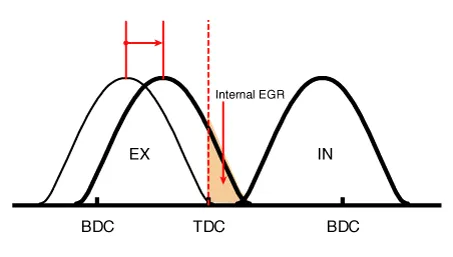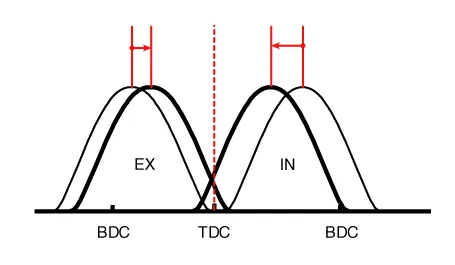Hyundai Elantra (CN7): Exhaust Emission Control System / CVVT (Continuous Variable Valve Timing) System
Hyundai Elantra (CN7) 2021-2025 Service Manual / Emission Control System / Exhaust Emission Control System / CVVT (Continuous Variable Valve Timing) System
Description and operation
| Description |
Continuous Variable Valve Timing (CVVT) system advances or retards the valve timing of the intake and exhaust valve in accordance with the ECM control signal which is calculated by the engine speed and load.
By controlling CVVT, the valve over-lap or under-lap occurs, which makes better fuel economy and reduces exhaust gases (NOx, HC). CVVT improves engine performance through reduction of pump loss, internal EGR effect, improvement of combustion stability, improvement of volumetric efficiency, and increase of expansion work.
This system consists of:
| – | the CVVT Oil Control Valve (OCV) which supplies the engine oil to the cam phaser or runs out the engine oil from the cam phaser in accordance with the ECM PWM (Pulse With Modulation) control signal, |
| – | and the Cam Phaser which varies the cam phase by using the hydraulic force of the engine oil. |
The engine oil released from the CVVT oil control valve varies the cam phase in the direction (Intake Advance/Exhaust Retard) or in the opposite direction (Intake Retard/Exhaust Advance) of the engine rotation by rotating the rotor connected to the camshaft inside the cam phaser.
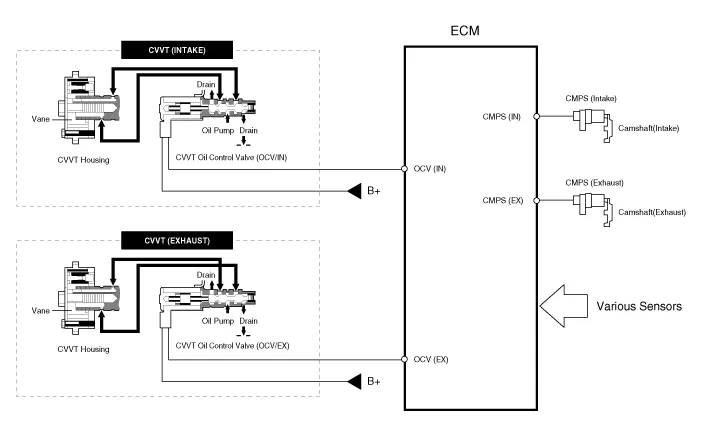
| Operation Principle |
The CVVT has the mechanism of rotating the rotor vane with hydraulic force generated by the engine oil supplied to the advance or retard chamber in accordance with the CVVT oil control valve control.
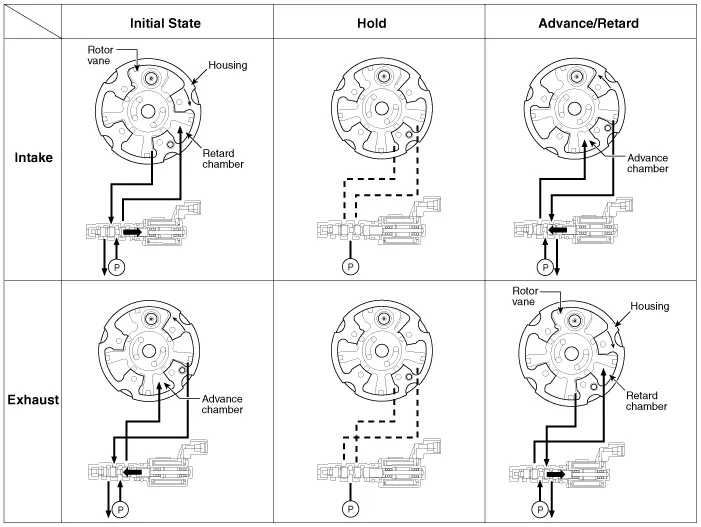
[CVVT System Mode]

| (1) Low Speed / Low Load | (2) Partial Load |
|
|
| (3) Low Speed / High Load | (4) High Speed / High Load |
|
|
|
Driving Condition
|
Exhaust Valve
|
Intake Valve
| ||
|
Valve Timing
|
Effect
|
Valve Timing
|
Effect
| |
| (1) Low Speed /Low Load | Completely Advance | * Valve Under-lap * Improvement of combustion stability | Completely Retard | * Valve Under-lap * Improvement of combustion stability |
| (2) Part Load | Retard | * Increase of expansion work * Reduction of pumping loss * Reduction of HC | Retard | * Reduction of pumping loss |
| (3) Low Speed /High Load | Retard | * Increase of expansion work | Advance | * Prevention of intake back flow (Improvement of volumetric efficiency) |
| (4) High Speed /High Load | Advance | * Reduction of pumping loss | Retard | * Improvement of volumetric efficiency |
Description and operation DescriptionThe catalytic converter of the gasoline engine is a three way catalyst. It oxidizes carbon monoxide and hydrocarbons (HC), and separates oxygen from the oxides of nitrogen (NOx).
Other information:
Hyundai Elantra (CN7) 2021-2025 Service Manual: Description and operation
DescriptionThe immobilizer system will disable the vehicle unless the proper ignition key is used, in addition to the currently available anti-theft systems such as car alarms, the immobilizer system aims to drastically reduce the rate of auto theft.1.
Hyundai Elantra (CN7) 2021-2025 Service Manual: Description and operation
D
Categories
- Manuals Home
- Hyundai Elantra Owners Manual
- Hyundai Elantra Service Manual
- Repair procedures
- Heating, Ventilation and Air Conditioning
- Front Bumper
- New on site
- Most important about car
Copyright © 2025 www.helantra7.com - 0.0267
